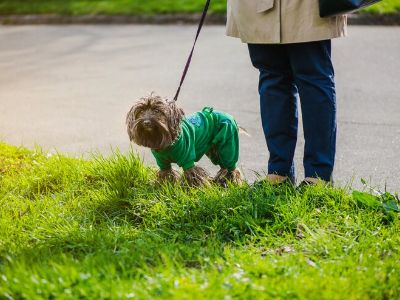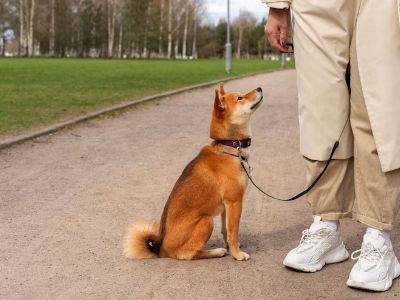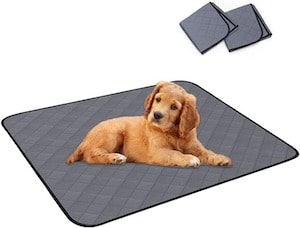Dog owners who frequently take their dogs out for walks have always wondered – why does my dog poop so much on walks? Well, there are a couple of reasons why your dog poops while walking. First- they are trying to mark their territory and second – walking for longer periods can trigger their bowel movements.
Now, if you are wondering – Is this behaviour normal? if not, How to control it? don’t worry. There are many dog owners across the country that have this same query. So, keep reading as we guide you through different prospects of a dog pooping while walking and some tips on stopping this.
You Might Also Like:
Why Does My Dog Poop So Much On Walks?
We mentioned that dog pooping while walking indicates two aspects i.e. marking territory behaviour and the triggered bowel moment because of walking. However, there are many other reasons why a dog poops on walks.

Let’s get into different reasons and understand why dogs poop on walks.
#1 Constipation
When you walk your dog and see them walking around in circles before pooping, is a sign of their bowels moving. But, if your dog is walking and pooping at the same moment, then it’s possible they are suffering from constipation.
The movement from walking can initiate their bowel movement and they will begin to poop. Also, it’s common for dogs to excrete their poop on their morning walk.
#2 Marking territory
We do know that a dog pees to mark their presence in a specific territory. But, they also poop to mark their presence. The poop of your dog leaves some mouldy scent behind. So, whenever they poop while walking it’s possible they are trying to mark that specific territory.
When they leave this scent while pooping, their fellow canine friends can easily get to know their health status, identity, age, and sex. If your dog was recently neutered, be sure to check how soon can i walk my dog after neutering before letting them mark territory.
#3 Muscle pain and weakness
Your furry friend has muscle pain issues and weakness around their butt and hence, at times they prefer pooping while walking. The reason is simple, they don’t have the strength to squat and release their poop. So, when they walk the activity stimulates bowel movement and they prefer pooping while walking.
Senior dogs are more likely to show this behaviour because they are not much active and their muscles get weak over time. This is the reason why senior dogs are walked as they are not able to poop normally.
#4 Movement helps stimulate bowel movement
At times dogs face difficulty in pooping and the movement from the walking will help in sliding out their poop with ease. Walking helps with the contraction of the muscles around the anus and facilitates easy bowel movement.
#5 Loose bowel control
It’s possible that your dog has a serious underlying medical condition. For example, they may have a digestive illness, injury near anal muscles or a blockage. In any of these instances, they will find it tough to control their bowel movement.
So, when you are on a walk they will poop without any prior indication because they have less bowel control. You may have to address the situation because the problem can elevate and you will see your dog poop around in the house.
#6 Nutrition imbalance
A poor diet will often create nutritional imbalance and have an instant effect on a dog’s digestive system. Thus your furry friend will either have constipation or diarrhoea. If they have diarrhoea, it’s very tough for them to control their bowel movements.
So, whenever their nutrition is poor, their pooping behaviour will change. You will have to address the situation and make the necessary changes to their diet.
#7 Habit
As a pup, peeing and pooping accidents are quite common. As the dog has difficulty in holding their bladder and bowel movements. This incapacity is often a result of the inability to control their bladder and bowels at a young age. So, the habit of pooping or peeing without any proper control stays the same.
Hence, training them to have a bit more control over their bowels is one of the most challenging tasks for a dog owner. As they have to change their habit that has been there for years.
#8 Anxiety
Dogs can get scared while walking in an unknown environment. So, whenever you will take them through an unknown route or a passage the anxiety may kick in. The movement from walking is already loosening their anal muscles and the anxiety is ultimately initiating bowel movement.
The situation for them is tense and they will not wait to squat and release their poop in a comfortable area. Rather, they prefer it releasing out while they are walking.
#9 Increased and stuck poop
At times, poop itself is the issue. A lengthy pop can cause issues and you will see your dog shuffle to loosen such distended poop. Also, sometimes the grass, hair and sticks can make your dog’s poop stuck inside.
These hair and grass material gets stuck and massive clumps of poop gets accumulated inside. As a result, the dog will get an upset stomach. Under such circumstances, they will have to exert more force than usual while pooping. So, to avoid exerting additional pressure on their bowel muscles, you will see them poop while walking.
#10 Excitement
This one is strange but, dogs often get excited while walking. In general, they just happen to go outside and the excitement takes over. They will begin to jog across the area and poop while they continue to move.
This instance is funny ad probably the only one where you do not have to worry about their health. You can easily calm their behaviour and make them poop in different places once they get used to walking.
We saw different reasons and situations explaining why dog poops while walking. Now, as a dog owner, it’s obvious for you to think – how to control this pooping issue?
Well, before you attempt to train them, you’ll need to know the pooping behaviour of dogs and have an idea regarding their colour, and schedule. Here is a simple breakdown,
- Colour: a healthy dog will offload brown colour poop. Variance in colour will indicate different aspects. For instance, if the colour is green, then it means they have ingested grass. Likewise, if you see the poop colour being black, or maroon with red streaks, it will suggest bleeding in the intestinal tract.
- Layering: if your dog’s stool has layering over it i.e. appears like mucus it is a sign of high bowel inflammation which may suggest diarrhoea.
- Type: look at the dog poop and see whether it’s solid, firm, or liquid. This will help in determining their digestive health condition. If you observe watery poop for longer periods then there is some health issue.
- Organisms: you need to ensure that your dog’s poop doesn’t have worms, chunks of fur or grass in them. Also, make sure there is no solid object as well, for instance, a toy.
- Frequency: knowing how many times your dog poops in a day is important. For instance, if the pooping frequency is 2-3 times a day, you can assume they are in a healthy state. Likewise, if they are not pooping at all there is a possible blockage or some other issue. Also, if they are pooping more than usual you can know that they are suffering from constipation or diarrhoea.
These aspects will help you outline the best possible training for your furry friend. You can use different strategies to make them poop better and also help with control.
Training Dogs To Control Poop While Walking

The basic step, to begin with, is training your dog to poop in a different location. This will require you to associate some cues that will suggest them not to poop while walking. You also need to set up their pooping routine and take the necessary steps to ensure they know that pooping while walking is not acceptable.
- Set up some commands: take your dog outside in the backyard, or any specific area you want your dog to poop. Walk with them and make sure you associate some commands to stop them from popping while walking. You can use commands such as “No”, “Not now” or “Not here”.
- Allow pooping: once you manage to associate the phrases the next time you go out on a walk you can use them. But, before that, you need to train them to poop on your command as well. So now if you see them willing to poop while walking you can take them to a different location and allow them to offload their stool. To instruct them, use “go”, or “go potty” commands.
- Reward: if they control their poop and only release it after your command, give them a reward. Afterwards, you can also try bathing them and acknowledge their behaviour for registering a positive remark in their mind.
- Set up a new location: when you have to train the dog not to poop while walking, you will have to set a specific location. You will have to reward them frequently if they hold their poop and release it after your command.
These were some basic tricks you can use for training your dog not to poop while walking. In addition, you also need to ensure your behaviour stays normal. Here are a few things you must avoid doing:
- Don’t punish your dog for pooping while walking. This can unsettle their behaviour and also make them feel scared If they get scared, they may even stop pooping.
- You may think not taking your dog for a walk may solve the issue but, it won’t. Many dogs need walks to stimulate their bowel movements.
- Avoid forcing your dog to poop at home. This can make them poop less and because they will exert more pressure, they may get a painful feeling in their anal region.
When taking your puppy for a walk to train them, it’s important not to overdo it. Be mindful of how far can a puppy walk based on their age and breed.
FAQs
Why does my dog walk in circles when pooping?
One of the common perceptions behind dogs walking in circles while pooping is getting a clear view of the surrounding environment to ensure there are no potential threats or predators around. Also, they like their place to be clean before they poop and circling helps them clear the bugs or other creatures in that area.
What happens if a dog holds his poop for so long?
While you train your dog to hold poop while walking, often they start holding it for longer than necessary. Because if they do hold their poop for longer periods, especially while walking, they will face severe health issues. Their colon gets damaged, they will have swelling near the anal region, and so on.
How many times should I walk my dog to poop a day?
If your dog prefers pooping while walking or after going outside, you can walk them twice a day for a healthy bowel movement. You take them for a walk after half an hour of their meal. Notice their poop colour and also observe the dog’s behaviour while pooping. This will help you know whether there is a need for a change in timings or identify any pooping issues.
How long can a dog hold their poop?
A puppy can hold their poop for approximately one hour each month old they are. This means an eight-month-old puppy will hold their poop for 8 hours. Remember, senior or sick dogs won’t have the same strength as young dogs to hold their poop. And that’s why these dogs are more likely to poop while walking.
Why Does My Dog Poop So Much On Walks – Final Remark
If your dog is going out for the first time, chances are they will poop while walking. This pooping is triggered because of the excitement and overwhelming feeling of getting back out in the wild. Some dogs are also known to develop this routine of pooping while walking because it’s the only way that works for them.
Also, they will leave their poop for other dogs to smell. This is their way to communicate and let each other know about their health, location, and gender. In addition, you also need to monitor the colour and shade of your dog’s poop to ensure they are not suffering from any gastrointestinal issues. If you do find any, as an experienced veterinary, I would suggest you immediately consult your vet.
A visit to the vet will help determine whether your dog is having constipation or diarrhoea. Lastly, it’s important to train your dog to not poop while walking and if you find it difficult in training them you can hire a professional dog trainer.
Investing in the best dog walking torch can make those evening and nighttime strolls easier when it comes to monitoring your dog’s potty habits






